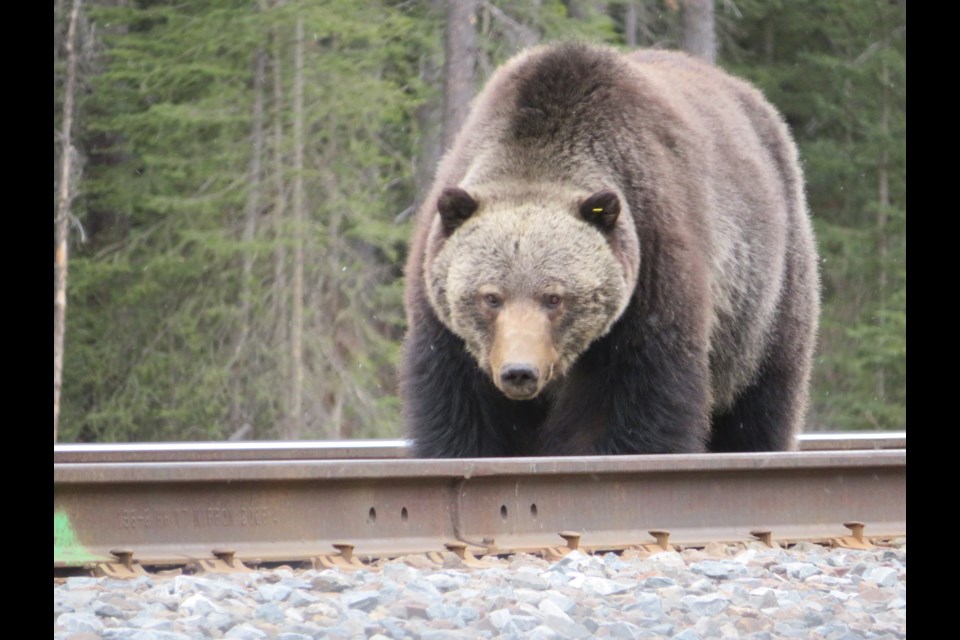BANFF – A male grizzly bear in Banff National Park with a badass reputation has killed and eaten another grizzly bear cub.
Bear No. 136, nicknamed Split Lip for his disfigured mouth, killed a two-and-a-half year cub belonging to well-known mamma bear No. 142 near Morant’s Curve along the Bow Valley Parkway Thursday (April 30).
Parks Canada wildlife experts say Split Lip was seen feeding on the grizzly cub carcass, which prompted an immediate closure of the parkway between Baker Creek and Whitehorn Road for public safety reasons and to give the bear space and security.
“Bear 136 killed one of the cubs of 142… this is a natural occurrence in the wild,” said Jon Stuart-Smith, a Parks Canada human-wildlife coexistence specialist for Lake Louise, Yoho and Kootenay national parks.
“We do as much as we can to ensure the viability of grizzly bear populations in the park, so it’s something that’s hard to not sort of anthropomorphize and see as something that’s negative or unfortunate, but this is part of their biology and genetics.”
This is not the first time Split Lip has been known to have an appetite for other bears.
In 2015, this notorious bear likely killed, but definitely ate, another grizzly bear in the Mystic Pass area of Banff National Park. When Split Lip’s collar stopped working, wildlife specialists went to investigate based on the last GPS location.
They found the fully-consumed carcass of another grizzly bear close to Split Lip’s discarded collar, which may have come off as he rubbed against a tree. It was later determined the grizzly bear was No. 132.
In 2014, Split Lip was also the prime suspect in killing cubs belonging to bear No. 130, who was also collared as part of the 2012-17 Canadian Pacific-Parks Canada study to look at grizzly mortality on the railway.
Lindsay McPherson, a communications officer with Lake Louise, Yoho and Kootenay, said Split Lip may also have been responsible for the disappearance of another set of cubs, belonging to female bear 138. She had two sets of cubs.
“The first set of cubs disappeared and 136 was in the vicinity when that happened, so he is suspected in that incident, but there is no direct evidence to confirm this,” said McPherson, noting mamma bear 138 hasn’t been seen or captured on remote cameras since fall 2018. “We don’t know if she is alive. We have no evidence that 136 was the cause of her disappearance.”
Stuart-Smith said this most recent case involving bear No. 136 is not the first time he has tried to predate on bear 142’s cubs, pointing to an incident at Upper Lake Louise last spring.
“There was an incident at the lake itself where 142 and her cubs ended up running across the half frozen lake to try and get away from 136 – and she was successful that time,” he said.
“But 136 was finally successful after numerous attempts that we are aware of, and obviously others that we are not aware of. It’s just one of those things that are a part of male grizzly bears’ genetics.”
For now, female bear 142 will be desperately trying to protect her remaining cub from Split Lip, and the Bow Valley’s most dominant grizzly, bear No. 122. Also known as The Boss, he’s been seen out and about since coming out of his den at the end of February.
Mamma bear 142 spends a great deal of time in the Lake Louise area as well as along the Bow Valley Parkway, including occasions on the grassy patch at the grounds of the Fairmont Chateau Lake Louise last year.
“She does tend to spend time in fairly highly used areas and that’s probably a strategy for her to try to protect herself and her cubs from these larger males,” said Stuart-Smith.
“That’s a strategy that’s been studied in other locations around the world.”
Grizzly bears also head into breeding season late May and into June, a time when large male grizzly bears will seek to kill cubs.
“One of the theories is they kill the cubs of a female, then perhaps she will go back into breeding status and they’ll be able to breed that female and have their own cubs,” said Stuart-Smith.
“We don’t know for sure what the genetics are of these cubs; sometimes male grizzlies will kill their own offspring.”
A prominent bruin in the Lake Louise area, No. 142 is the offspring of her famed mother, bear No. 72, a 22-year-old female grizzly and former matriarch who died several years ago when she fell off a cliff in icy conditions. Her sibling is bear No. 143, a grizzly that is more wary.
Bear 142, believed to be about 10 years old, caused some anxious moments last July when she punched two holes in a tent trying to get food inside. There was a bag of oats inside, but the bear and her cubs were scared off before they could get the food.
Meanwhile, the section of the Bow Valley Parkway between Baker Creek and Whitehorn Drive in Lake Louise remains closed until further notice while Split Lip remains in the area.
The section between the east end of the parkway at its junction with the Trans-Canada Highway to its junction with Highway 93 South were previously closed.
“At this point, we are just monitoring the situation until 136 moves on and we can assess whether there’s anything left to be concerned about,” said Stuart-Smith.
In 2017, Split Lip caused anxious moments when he tried to amble over the pedestrian bridge across the Bow River in Banff, and while he wasn’t aggressive, he also wasn’t giving way to about 20 hikers on a trail at Johnston Canyon in 2016.
There are an estimated 60 grizzly bears in Banff National Park. The species is considered threatened in Alberta.




